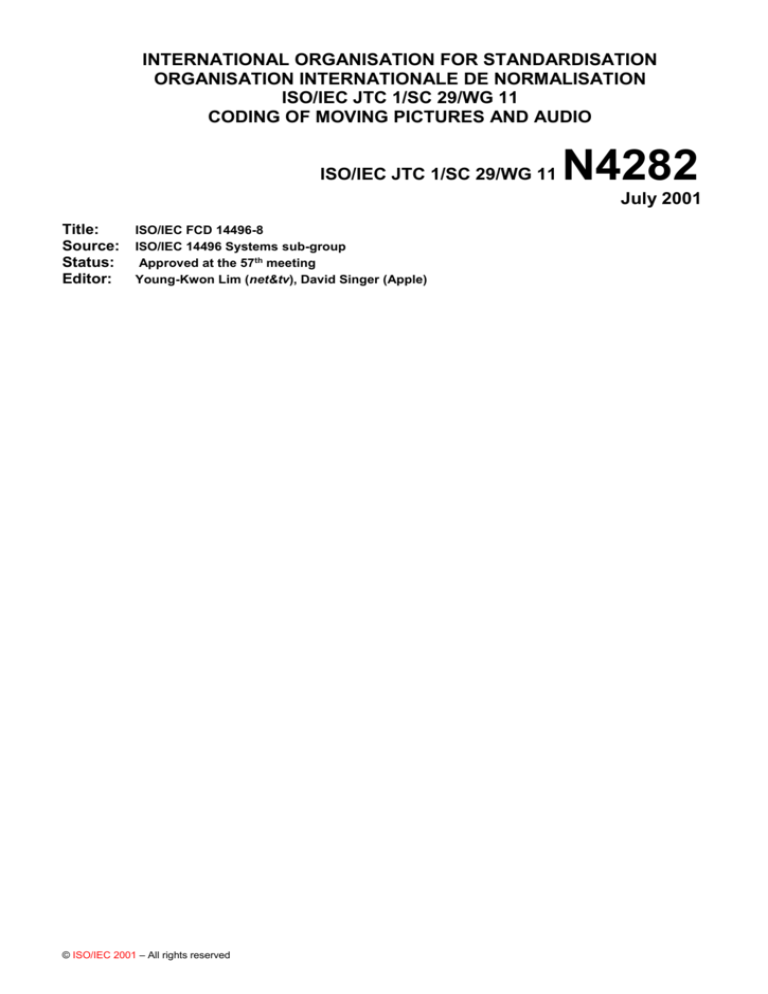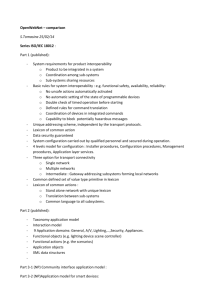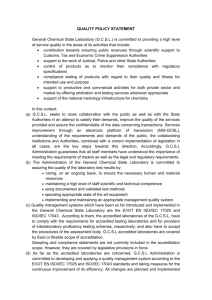
INTERNATIONAL ORGANISATION FOR STANDARDISATION
ORGANISATION INTERNATIONALE DE NORMALISATION
ISO/IEC JTC 1/SC 29/WG 11
CODING OF MOVING PICTURES AND AUDIO
ISO/IEC JTC 1/SC 29/WG 11
N4282
July 2001
Title:
Source:
Status:
Editor:
ISO/IEC FCD 14496-8
ISO/IEC 14496 Systems sub-group
Approved at the 57th meeting
Young-Kwon Lim (net&tv), David Singer (Apple)
© ISO/IEC 2001 – All rights reserved
ISO/IEC 14496-8:2001(E)
Information technology – Coding of audio-visual objects –
Part 8: Carriage of ISO/IEC 14496 contents over IP networks
ISO/IEC 2001 – All rights reserved
ISO/IEC 14496-8:2001(E)
Contents
1
Scope .............................................................................................................................................................. 1
2
Normative References ................................................................................................................................... 1
3
Additional References ................................................................................................................................... 2
4
Definitions ...................................................................................................................................................... 2
5
Abbreviations and Symbols.......................................................................................................................... 2
6
Use of RTP ...................................................................................................................................................... 2
6.1
Carrying a single elementary stream ........................................................................................................... 2
6.2
Carrying a FlexMux stream ........................................................................................................................... 3
6.3
Payload format selection .............................................................................................................................. 4
6.4
ISO/IEC 14496QoS considerations ............................................................................................................... 4
7
Usage of SDP attributes ................................................................................................................................ 4
8
MIME Types .................................................................................................................................................... 5
9
RTSP usage .................................................................................................................................................... 6
10
Use of URLs in ES_Descriptors ................................................................................................................... 7
11
Security Considerations................................................................................................................................ 7
12
Multicast Considerations .............................................................................................................................. 7
ISO/IEC 2001 – All rights reserved
ISO/IEC 14496-8:2000(E)
Foreword
Iv
ISO/IEC 2001 – All rights reserved
ISO/IEC 14496-8:2001(E)
Introduction
ISO/IEC 14496 is a standard designed for the representation and delivery of multimedia information over a variety
of transport protocols. It includes interactive scene management, visual and audio representations as well as
systems functionality like multiplexing, synchronization, and an object descriptor framework. This document
provides a framework for the carriage of ISO/IEC14496 contents over IP networks and guidelines for designing
payload format specifications for the detailed mapping of ISO/IEC 14496 content into several IP-based protocols
ISO/IEC 2001 – All rights reserved
IINTERNATIONAL STANDARD
ISOIEC CD 14496-8
Information technology Coding of audio-visual objects
Part 8: Carriage of ISO/IEC 14496 contents over IP networks
1
Scope
This part of ISO/IEC 14496 specifies transport level functionalities for the communication of interactive audio-visual
scenes. More specifically:
1. Framework for the carriage of ISO/IEC 14496 contents over IP networks
2. Guidelines to design RTP payload formats for ISO/IEC 14496 contents including fragementation and
concatenation rules
3. Usage rules of SDP to transport ISO/IEC 14496-1 related informations
4. MIME type definitions for ISO/IEC14496 contents
5. Analysis on RTP Security and Multicasting
2
Normative References
The following IETF RFCs and International Standards contain provisions, which, through reference in this text,
constitute provisions of ISO/IEC 14496. At the time of publication, the editions indicated were valid. All RFCs and
Standards are subject to revision, and parties to agreements based on ISO/IEC 14496 are encouraged to
investigate the possibility of applying the most recent editions of the standards indicated below. Members of IEC
and ISO maintain registers of currently valid International Standards. The Internet Engineering Task Force
maintains a list of currently valid RFCs
H. Schulzrinne, et. al., "RTP : A Transport Protocol for Real-Time Applications", IETF RFC 1889, January 1996.
H. Schulzrinne, et. al., "RTP Profile for Audio and Video Conference with Minimal Control", IETF RFC 1890,
January 1996.
H. Schulzrinne, et. al., " Real Time Streaming Protocol (RTSP)", IETF RFC 2326, April 1998.
M. Handley, " SDP: Session Description Protocol", IETF RFC 2327, April 1998.
D.Curet et al., " RTP Payload Format for MPEG-4 FlexMultiplexed Streams", IETF Draft, draft-curet-avt-rtp-mpeg4flexmux-00.txt, Feburary 2001, expires August 2001.
Yoshihiro Kikuchi et al., " RTP Payload Format for MPEG-4 Audio/Visual Streams", IETF RFC 3016, November
2000
P. Gentric et al., “RTP Payload Format for MPEG-4 Streams”, IETF Draft, draf, draft-ietf-avt-mpeg4-multiSL-01.txt,
July 20, 2001, expires January 20, 2002
ISO/IEC 2001 – All rights reserved
1
ISO/IEC 14496-8:2001(E)
3
Additional References
4
Definitions
4.1 RTP
The Real Time Transport Protocol, or RTP is an Internet protocol used for transport of multimedia data.
4.2 RTSP
The Real Time Streaming Protocol, or RTSP, is an application-level internet protocol for control over the delivery of
data with real-time properties.
4.3 RTCP
The Real Time Transport Control Protocol, or RTCP, is an Internet protocol used to configure RTP packets and to
control the transport of RTP packets.
4.4 SDP
SDP is an Internet protocol used for describing multimedia sessions for the purposes of session announcement,
session invitation, and other forms of multimedia session initiation.
5
Abbreviations and Symbols
AAC
AU
BIFS
CELP
CTS
ES
ESI
ESID
FCR
IETF
OCR
OD
ODID
QoS
RFC
SL
SL-Packet
URL
6
Adavanced Audio Coding
Access Unit
Binary Format for Scene
Code Excited Linear Prediction
Composition Time Stamp
Elementary Stream
Elementary Stream Interface
Elementary Stream Identifier
FlexMux Clock Reference
Internet Engineering Task Force
Object Clock Reference
Object Descriptor
Object Descriptor Identifier
Quality of Service
Request For Comments
Synchronization Layer
Synchronization Layer Packet
Universal Resource Locator
Use of RTP
There are a number of RTP packetization schemes for ISO/IEC 14496 data. Media-aware packetization (e.g. video
frames split at recoverable sub-frame boundaries) is a principle in RTP, and thus it is likely that several RTP
schemes will be needed, to suit both the different kinds of media - audio, video, etc. – and different encodings (e.g.
AAC and CELP audio codecs).This specification does not specify any payload format but do specify a general
framework to design and utilize the payload formats in appropriate way..
This specification requires that, no matter what packetization scheme is used, there are a number of common
characteristics that all shall have: however, such characteristics depend on the fact that the RTP Session contains
a single elementary stream or a flexmux stream.
6.1
Carrying a single elementary stream
In case an RTP Session contains a single elementary stream the following characteristics apply:
The RTP timestamp corresponds to the presentation time (e.g. CTS) of the earliest AU within the packet.
RTP packets have sequence numbers in transmission order. The payloads logically or physically have SL
Sequence numbers, which are in decoding order, for each elementary stream.
2
ISO/IEC 2001 – All rights reserved
ISO/IEC 14496-8:2001(E)
The ISO/IEC 14496 timescale (clock ticks per second), which is timeStampResolution in the case of ISO/IEC
14496 Systems, shall be used as the RTP timescale, e.g. as declared in SDP for an RTP stream.
To achieve a base level of interoperability, and to ensure that any ISO/IEC 14496 stream may be carried, all
receivers should implement a generic payload format defined in “draft-ietf-avt-mpeg4-multisl-00.txt” as default
RTP payload mapping scheme. Any new payload format should be a configurable subset of the generic
payload format.
Streams should be synchronized using RTP techniques (notable RTCP sender reports). When the ISO/IEC
14496 OCR is used, it is logically mapped to the NTP time axis used in RTCP.
The RTP packetization schemes may be used for ISO/IEC 14496 elementary streams 'standing alone' (e.g.
without ISO/IEC 14496 systems, including BIFS); or they may be used within an overall presentation using the
object descriptor framework. In the latter case, an SLConfigDescriptor is sent describing the stream. Logically,
each RTP stream is passed through a mapping function which is specific to the payload format used; this
mapping function yields an SL packetized stream. The SLConfigDescriptor describes this logical stream, not
the actual bits in the RTP payload. For example, the RTP sequence number may be used to make the
SLPacketHeader sequence number; other SL fields may be set in this way, dynamically, or from static values
in the payload specification. For example, as all RTP packets carry a composition time-stamp, the flag in the
SL header indicating its presence can normally be statically defined as 'true'. Each payload format for ISO/IEC
14496 content SHALL specify the mapping function for the formation of the SLConfigDescriptor and the
SLPacketHeader. In the case of the RFC 3016, the mapping shall be defined in a new section.
Figure 1 – RTP packet to SL packet mapping
6.2
Carrying a FlexMux stream
In case an RTP Session contains a flexmultiplexed stream the following characteristics apply:
There is a single payload format for the carriage of Flexmux Streams over RTP. Senders and receivers may
implement this scheme.
The RTP timestamp corresponds to the FCR if present at the FlexMux level.
The ISO/IEC 14496 Flexmux timescale (FCR resolution in ticks per second) should be used as the RTP
timescale (as can be declared in SDP).
ISO/IEC 2001 – All rights reserved
3
ISO/IEC 14496-8:2001(E)
6.3
the ISO/IEC 14496 FCR is logically mapped to the NTP time axis used in RTCP.
Payload format selection
Other payload formats may be used. They are signalled as dynamic payload IDs, defined by a suitable name (e.g.
a payload name in an SDP RTPMAP attribute). In particular, the development of specialized RTP payloads for
video (e.g. respecting video packets) and audio (e.g. providing interleave) is expected. It is possible that these
schemes can be compatible with the default scheme required here.
There may be a choice of RTP payload formats for a given stream (e.g. as an elementary stream, an SLpacketized stream, using FlexMux, and so on). It is recommended that
terminals implementing a given sub-system (e.g. video) accept at least an ES and the default SL packings of
that stream; for example, this means accepting the RFC 3016 and also the generic payload format for MPEG4 Visual;
terminals implementing a given payload format accept any stream over that format for which they have a
decoder, even if that packing is not normally the 'best' packing.
6.4
ISO/IEC 14496QoS considerations
For those streams requiring a certain Quality of Service (specifiable appropriately) , the recommendation is to
further investigate possible solutions such as the leverage of existing work in the IETF in this area (including, but
not limited to FEC, re-transmission, or repetition). However, techniques in data-dependent error correction, or
combined source/channel coding solutions make other schemes attractive [7]. Also, it is recommended that
requirement such as efficient grouping mechanisms (i.e. the ability to send in a single RTP packet multiple
consecutive AUs, each with its own SL information) and low overhead are also taken into account.
7
Usage of SDP attributes
This specification considers only ISO/IEC 14496 Systems related issues. Usage of SDP information for specific
payload format shall be specified in each RTP payload format RFCs. The usage of elementary streams in other
contexts is not addressed here: codepoints for this case are specified in [?], and in other places.
This specification currently assumes that any session described by SDP (e.g. in SAP, as a file download, as a
DESCRIBE over RTSP) has at most one ISO/IEC 14496 session. It is desirable that this restriction be lifted.
Senders should alert receivers that an ISO/IEC 14496 session is included, by means of an SDP attribute that is
general (i.e. before any "media" lines). This takes the form of one of the following attribute lines:
1. a=mpeg4-iod [<location>]
location: In an RTSP session, this is an optional attribute. If not supplied, the IOD is retrieved over the RTSP
session by using DESCRIBE with an accept of type application/mpeg4-iod. Where the SDP information is
supplied by some other means (e.g. as a file, in SAP), the location is obligatory. The location should be a URL
enclosed in double-quotes, which will supply the IOD (e.g. small ones may be encoded using "data:",
otherwise "http:" or other suitable file-access URL). The InitialObjectDescriptor is defined in sub-clause 8.6.3.1
of ISO/IEC 14496-1.
or:
2. a=mpeg4-iod-xmt [<location>]
location: In an RTSP session, this is an optional attribute. If not supplied, the IOD is retrieved over the RTSP
session by using DESCRIBE with an accept of type application/mpeg4-iod-xmt. Where the SDP information is
supplied by some other means (e.g. as a file, in SAP), the location is obligatory. The location shall be a URL
enclosed in double-quotes, which will supply the IOD in XMT format (e.g. small ones may be encoded using
"data:", otherwise "http:" or other suitable file-access URL). The InitialObjectDescriptor is defined in sub-clause
8.6.3.1 of ISO/IEC 14496-1, and its XMT format is defined in ISO/IEC 14496-1 2001 PDAM 2.
Any receivers using IOD shall understand binary IOD and may understand textual IOD.
4
ISO/IEC 2001 – All rights reserved
ISO/IEC 14496-8:2001(E)
New encoding names for the a = rtpmap attribute It is recommended that, no matter what payload format is
used, each media stream be placed in a media section that is appropriate. For example, a payload format
which can carry both video and audio streams may be used in sections of SDP starting both with "m=video"
and "m=audio". The MIME name for the payload format is thus registered under all applicable branches.
a = rtpmap:<payload> <name>/<time scale>/<parameters>
payload is the dynamic payload number. The <name> is defined and documented in the IETF specification for
the payload format; for example, mpeg4-SL might indicate the encoding type of the media, one ISO/IEC
14496 SL packetized stream, or mpeg4-flexmux might indicate the encoding type of the media, one ISO/IEC
14496 FlexMux stream. <time scale> is the time scale of the RTP time stamps parameters if used, is defined in
the RTP payload format
The mapping of RTP streams to elementary streams needs to cover the Flexmux case as well as the single
stream. Within the SDP information, a stream-specific attribute should be present for each ISO/IEC 14496
stream. It takes one of two forms, depending on whether a single elementary stream, or a flexmux, is carried.
In case of a single elementary stream, the following attribute is defined:
a=mpeg4-esid a
a is the ESID.
8
Other SDP attributes should, if used, carry values consistent with those carried in ISO/IEC 14496 systems (for
example, bit rate).
MIME Types
MIME type for ISO/IEC 14496 is declared under “video”. For presentations with audio information and no
visual aspect, the "audio" top-level mime type may be used; otherwise, "video" is used.
ISO/IEC 14496-1:2001 includes a standard file type for encapsulating ISO/IEC 14496 data. This file type can
be used in a number of ways: perhaps the most important are its use as an interchange format for ISO/IEC
14496 data, its use as a content-download format, and as the format read by streaming media servers. These
first two uses will be greatly facilitated if there is a standard MIME type for serving these files (e.g. over HTTP).
The ISO/IEC 14496 standard is broad, and therefore the type of data that may be in such a file can vary. In
brief, simple compressed video and audio (using a number of different compression algorithms) can be
included; interactive scene information; meta-data about the presentation; references to ISO/IEC 14496 media
streams outside the file and so on. The MIME types to be assigned to MP4 files should be "audio/mp4", and
"video/mp4" , based on the criteria in 4.1. In either case, these indicate files conforming to the "MP4"
specification (ISO/IEC 14496-1:2001, systems file format).
When an MP4 file is served (e.g. over HTTP) or otherwise shall be identified by a MIME type, the type
"video/mp4" should be used. The types "audio/mp4" may be used when the ISO/IEC 14496 presentation
contained within the MP4 file has no visual presentation and refers to a pure audio presentation.
When a visual ISO/IEC 14496 ES is served (e.g. over HTTP or otherwise) and shall be identified by a MIME
type, the type "video/MPEG4-visual" shall be used. This MIME type may require optional parameters to carry
all necessary information to configure a receiver: therefore no further meta-information (such as that defined by
the MP4 file format or by the ISO/IEC 14496 Object Descriptor framework) has to be provided in the data, and
the data itself merely represents the media content. The format of the bit-stream, including timing etc., is
defined in ISO/IEC 14496-2.
In some cases, the initial object descriptor needs to be identified with a MIME type. In this case, the type
“applications/mpeg4-iod” shall be supported, and the type “application/mpeg4-iod-xmt” may be supported. In
the latter case, the IOD will be described in an XMT textual format. The InitialObjectDescriptor is defined in
sub-clause 8.6.3.1 of ISO/IEC 14496-1, and its XMT format is defined in ISO/IEC 14496-1:2001 PDAM 2.
When a flexmux stream is served (e.g. over HTTP) or otherwise shall be identified by a MIME type, the type
"application/mpeg4-flexmux" SHALL be used. These files consist of concatenated flexmux PDUs in
transmission order.
ISO/IEC 2001 – All rights reserved
5
ISO/IEC 14496-8:2001(E)
In some cases, the information needed by a flexmux decoder needs to be identified with a MIME type. In this
case, the type "application/mpeg4-flexmuxinfo" should be used.
The payload names used in an RTPMAP attribute within SDP, to specify the mapping of payload number to its
definition, also come from the MIME namespace. Each of the RTP payload mappings defined above has a
distinct name. It is recommended that visual streams be identified under "video", and audio streams be
identified under "audio", and otherwise "application" be used.
9
MIME media type name:video, and audio
MIME subtype name:mp4
MIME media type name:application
MIME subtype name:mpeg4-iod, mpeg4-flexmux, mpeg4-flexmuxinfo
Required parameters:none
Optional parameters:none
Encoding considerations:base64 generally preferred; files are binary and should be transmitted without
CR/LF conversion, 7-bit stripping etc.
Security considerations:See below
Interoperability considerations:A number of interoperating implementations exist within the ISO/IEC
14496 community; and that community has reference software for reading and writing the file format.
Published specification:ISO/IEC 14496-1:2001
Applications:Multimedia
Additional information:
Magic number(s):none
File extension(s):mp4 and mpg4 are both declared at <http://pitch.nist.gov/nics/>
Macintosh File Type Code(s):mpg4 is registered with Apple
Person to contact for info:David Singer, singer@apple.com
Intended usage:Common
Author/Change controller:David Singer, ISO/IEC 14496 file format chair
RTSP usage
This specification considers only ISO/IEC 14496 Systems related issues. The usage of elementary audio or visual
streams in other context does not require any specific statement about RTSP. RTSP may be used as a session
control protocol for sessions which carry ISO/IEC 14496 information. When RTSP is used as a session-control
protocol:
RTP should be used as the transport protocol.
The initial DESCRIBE format should be SDP. If the SDP information reveals that an IOD is needed, and the
terminal does not already have it, then a second DESCRIBE accepting an IOD should be performed (see
above).
Note that if all ISO/IEC 14496 streams are closed (TEARDOWN) then the RTSP session ID will be lost. The
next (re-)opened stream will supply a new session ID. Care should be taken that the target of the URL has not
changed in the interval; new DESCRIBEs may be needed.
6
ISO/IEC 2001 – All rights reserved
ISO/IEC 14496-8:2001(E)
10 Use of URLs in ES_Descriptors
When it is necessary to reference an RTP stream directly from an ES_Descriptor, the URL field of the descriptor
can be used.
For example, the URL could contain the SDP description of the stream using the
“data:application/sdp” scheme.
When it is necessary to embed stream data directly inside an ES_Descriptor, the URL field of the descriptor can be
used. For example, the URL could contain the data using the correct MIME type. In this case, the data consists of
one SL packet that contains one access unit.
11 Security Considerations
RTP packets using the payload formats referred to in this specification are subject to the security considerations
discussed in the RTP specification. This implies that confidentiality of the media streams is achieved by encryption.
Because the data compression used with this payload format is applied end-to-end, encryption may be performed
on the compressed data so there is no conflict between the two operations. The packet processing complexity of
this payload type does not exhibit any significant non-uniformity in the receiver side to cause a denial-of-service
threat. However, it is possible to inject non-compliant MPEG streams (Audio, Video, and Systems) to overload the
receiver/decoder's buffers which might compromise the functionality of the receiver or even crash it. This is
especially true for end-to-end systems like MPEG where the buffer models are precisely defined. ISO/IEC 14496
Systems supports stream types including commands that are executed on the terminal like OD commands, BIFS
commands, etc. and programmatic content like MPEG-J (Java(TM) Byte Code) and ECMASCRIPT. It is possible to
use one or more of the above in a manner non-compliant to MPEG to crash or temporarily make the receiver
unavailable. Authentication mechanisms can be used to validate of the sender and the data to prevent security
problems due to non-compliant malignant ISO/IEC 14496 streams. A security model is defined in ISO/IEC 14496
Systems streams carrying MPEG-J access units which comprises Java(TM) classes and objects. MPEG-J defines
a set of Java APIs and a secure execution model. MPEG-J content can call this set of APIs and Java(TM) methods
from a set of Java packages supported in the receiver within the defined securitymodel. According to this security
model, downloaded byte code is forbidden to load libraries, define native methods, start programs, read or write
files, or read system properties. Receivers can implement intelligent filters to validate the buffer requirements or
parametric (OD, BIFS, etc.) or programmatic (MPEG-J, ECMAScript) commands in the streams. However, this can
increase the complexity significantly.
12 Multicast Considerations
When using IP Multicast, the SDP information describing the ISO/IEC 14496 Session should be made available to
the terminal. In addition, elementary stream descriptors may use URLs to directly address ESs. The goal of such
URL would be to convey information to enable the terminal to directly connect to the RTP channel carrying the ES.
The URL may contain the SDP information required to access the stream as described in section 10 above.
ISO/IEC 2001 – All rights reserved
7






